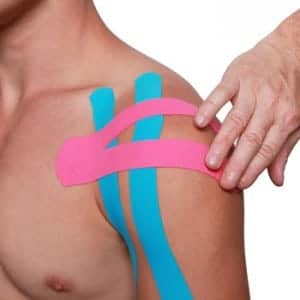Taping
Traditionally when you hear of strapping and taping you think of support and restricted movement of painful or injured areas. Until a few years ago you wouldn’t be far wrong with those thoughts, however there has been a recent evolvement in both types of tape and strapping techniques which has led to the development of various different therapeutic applications some of the most common of these have been discussed below.
Rigid Taping
This is more like the traditional taping methods which we have all become accustomed to. It still has it’s place in injury management although all be it in a much reduced capacity. It is designed to reduce he range of movement available around the injured site and in turn this reduces the stress on the damaged tissues. It is of particular use in the treatment of plantar fasciitis during the very acute phase. However this taping technique would not normally be utilised for greater than 48 hours. After his time other methods such as those mentioned below would be incorporated into a comprehensive and individualised plan of management.

Kinesio Tape
Have you noticed the brightly coloured tape adorning elite men and women during competitive events? This is known as kinesio tape and was specifically designed by a Japanese chiropractor Kenzo Kase in the 1970’s to be less restrictive than other tapes such as zinc oxide by stretching and moving with the skin. As a result it is thought to have many therapeutic benefits including relaxing overactive muscles, facilitating inhibited or weak muscles, pain relief, offload tension within specific neural tissues such as the sciatic nerve, increase lymphatic drainage and thus decrease inflammation, aid rehabilitation and enhance sporting performance.
How can one tape have so many different applications? This is simply down to the way the tape is applied. By varying the body position and/or stretch on the tape you can achieve a different therapeutic response. Therefore the benefits of kinesio taping rely on your practitioner identifying the cause of your symptoms and then applying the tape in such a way that will help to aid correction of your problem or facilitate your rehabilitation programme.
Offloading Specific Muscles and Joints
Specific Proprioceptive Rehabilitation Taping is a specific taping technique developed by Tim Brown in California to help offload specific muscles, tendons ligaments and/or joints during the rehabilitative stage of injury management. It’s aim is to create a pain free range of movement within which you can perform specific rehabilitation strengthening exercises and thus iit results in a quicker and more effective program.

